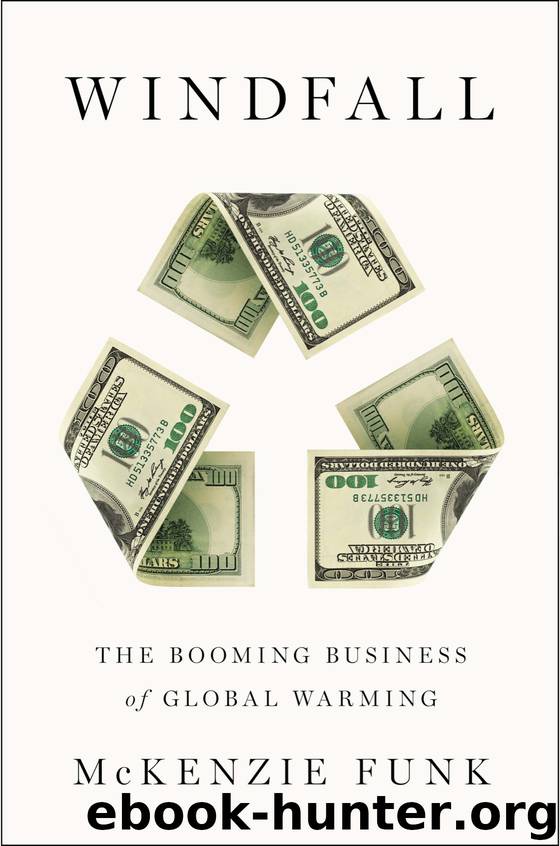Windfall by McKenzie Funk

Author:McKenzie Funk
Language: eng
Format: epub
Publisher: Penguin Group, USA
Published: 2014-01-22T16:00:00+00:00
EIGHT
GREEN WALL, BLACK WALL
AFRICA TRIES TO KEEP THE SAHARA AT BAY; EUROPE TRIES TO KEEP AFRICA AT BAY
The main highway out of Dakar, a band of blacktop linking the crowded Senegalese capital and the empty Sahel, was dusty and clogged on a summer day—jammed not only with cars but with people. Young men walked against the flow of traffic hawking peanuts, inflatable airplanes, steering wheel covers, oriental fans, telephone cards, and shrink-wrapped apples. Others stood where the sidewalks would have been, manning makeshift kiosks that sold French-language versions of Yahtzee and Monopoly, posters of sheikhs and imams, and drinking water in plastic sandwich baggies. The highway led to the desert, and the youths of Senegal were doing what they could to go in the opposite direction. Sell enough in a day, and they might be able to afford rice, the national staple, which now cost twice as much as six months earlier. Sell enough in a year, maybe two, maybe five, and they might be able to pay a smuggler to take them to Europe. Every minute or two, a new group approached our jeep, waving their wares expectantly. My host, Colonel Pape Sarr, a thin man who greeted everything else with a cavernous smile, wore a blank expression, staring resolutely ahead into the haze.
I was across the waist of Africa from Heilberg’s Sudanese tracts, some three thousand miles west, in the country that imports more food per capita than any other on the continent. Senegal gets three-quarters of its staples from abroad, including 150 pounds of rice a person each year—even as it, too, is a target of foreign farmland buyers. India would soon announce a 370,000-acre deal with Senegal’s Ministry of Agriculture, while Saudi Arabia’s Foras International would lay claim to 12,000 acres of rice paddies in the fertile Senegal River valley, the first piece of a planned 500,000-acre megafarm. But the scheme that drew Pape Sarr and me to the Sahel, the arid borderland between Africa’s humid tropics and the encroaching sands of the Sahara, was something else entirely: the Great Green Wall, Africa’s own response to climate change, a forty-seven-hundred-mile-long, ten-mile-wide barrier of trees meant to keep the Sahara at bay. If completed, it would cross eleven countries from the Atlantic Ocean to the Arabian Sea, from Senegal in the west to Djibouti in the east. Pape, a camouflage-clad officer of Eaux et Forêts, Senegal’s directorate of water and forests, was one of its architects. We were driving to see his men put the first seedlings into the ground.
The Great Green Wall was proposed in 2005 by Nigeria, where officials claimed desertification was consuming some 900,000 acres a year, and in 2007 it was officially endorsed by the African Union (AU). But in every country except Senegal, it so far existed only on paper. Standing before the press at the Copenhagen climate conference, Senegal’s president at the time declared that his nation would be like “the old Greek philosopher” Diogenes, “who proposed that you could prove the existence of motion” by standing up and walking.
Download
This site does not store any files on its server. We only index and link to content provided by other sites. Please contact the content providers to delete copyright contents if any and email us, we'll remove relevant links or contents immediately.
Bad Blood by John Carreyrou(6271)
Rich Dad Poor Dad by Robert T. Kiyosaki(6174)
Principles: Life and Work by Ray Dalio(5955)
Playing to Win_ How Strategy Really Works by A.G. Lafley & Roger L. Martin(5488)
Management Strategies for the Cloud Revolution: How Cloud Computing Is Transforming Business and Why You Can't Afford to Be Left Behind by Charles Babcock(4438)
The Confidence Code by Katty Kay(4033)
Thinking in Bets by Annie Duke(3995)
American Kingpin by Nick Bilton(3504)
Delivering Happiness by Tony Hsieh(3280)
Project Animal Farm: An Accidental Journey into the Secret World of Farming and the Truth About Our Food by Sonia Faruqi(3013)
The Power of Habit by Charles Duhigg(2962)
Mastering Bitcoin: Programming the Open Blockchain by Andreas M. Antonopoulos(2890)
Brotopia by Emily Chang(2889)
The Tyranny of Metrics by Jerry Z. Muller(2845)
I Live in the Future & Here's How It Works by Nick Bilton(2842)
The Marketing Plan Handbook: Develop Big-Picture Marketing Plans for Pennies on the Dollar by Robert W. Bly(2792)
The Content Trap by Bharat Anand(2776)
Building a StoryBrand by Donald Miller(2751)
Applied Empathy by Michael Ventura(2742)
